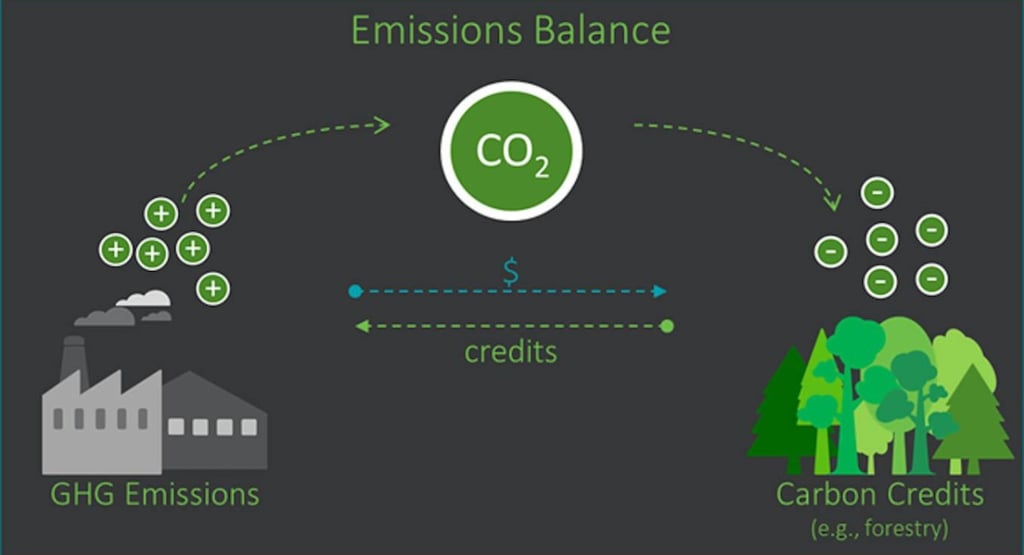India's Carbon Credit Market
India's carbon credit market is a framework for reducing greenhouse gas emissions and combating climate change: Purpose The carbon market helps reduce greenhouse gas emissions and improve the sustainability of natural habitats. Participants Individuals and companies can buy carbon credits to reduce their emissions. Carbon credits One carbon credit represents the reduction or removal of one ton of carbon dioxide equivalent (tCO2e) from the atmosphere. Carbon Credit Trading Scheme (CCTS) The CCTS is a domestic carbon trading system that will be regulated by the Ministry of Power (MoP). The CCTS will have two mechanisms: Compliance mechanism: Addresses emissions from the energy and industrial sectors Offset mechanism: Incentivizes voluntary actions from entities to reduce GHG emissions Launch The CCTS was initially scheduled for implementation in June 2023, but is now expected to launch in late 2025 or 2026. Challenges Some say that India's carbon credit trading system has limited coverage and missed an opportunity to address major polluters. Others say that India needs to streamline the roles of different bodies and establish punitive measures for noncompliance.
CARBON CREDIT
ICM
5/22/20242 min read


Okay, here's the lowdown on India's Carbon Credit Scene:
India's Foray into Carbon Credits
India's stepping up its game in the fight against climate change with its own carbon credit market. Think of it as a system designed to cut down on greenhouse gas emissions and boost environmental sustainability. Pretty important stuff, right?
Why Bother with Carbon Credits?
The main goal here is to reduce the bad stuff – greenhouse gas emissions. Plus, it's about making sure our natural habitats stay healthy and thrive. Basically, it's a win-win for the environment and, ultimately, for us.
Who's Playing the Game?
The beauty of this system is that it's not just for big corporations. Individuals and companies alike can jump in. They can buy these "carbon credits" to offset their own emissions. It's like saying, "Okay, we emitted this much, so we're investing in projects that reduce emissions elsewhere."
Decoding Carbon Credits
So, what exactly is a carbon credit? Simple. One carbon credit represents one less ton of carbon dioxide equivalent (tCO2e) chilling in the atmosphere. It's a tangible way to measure and trade emission reductions.
Enter the CCTS: India's Carbon Credit Trading Scheme
This is where things get official. India is rolling out its own domestic carbon trading system called the Carbon Credit Trading Scheme (CCTS). The Ministry of Power (MoP) is the one calling the shots here, making sure everything runs smoothly.
The CCTS has a couple of key tools in its arsenal:
Compliance Mechanism: This is focused on the big players – the energy and industrial sectors. It's designed to keep their emissions in check.
Offset Mechanism: This is more about encouraging voluntary action. It gives companies and even individuals a reason to reduce their emissions by offering incentives.
When's the Kick-Off?
Initially, the plan was to launch the CCTS in June 2023. But, like many big projects, it's facing a bit of a delay. We're now looking at a launch sometime in late 2025 or even 2026. So, it's coming, just not quite yet.
A Few Bumps in the Road
Of course, setting up something this big isn't without its challenges. Some folks are saying the current plan doesn't cover enough ground and might miss some major polluters. Others think India needs to make sure everyone knows who's responsible for what and have some real teeth – you know, penalties – for those who don't play by the rules.
Even with these hurdles, the development of India's carbon credit market is a significant step. It sets the stage for a more sustainable future and gives businesses a new way to contribute to the global effort against climate change.
Indian Carbon Market
Explore carbon credit trading in India digitally.
info@indcarbonmarket.com
+91-8007860989
© 2025. All rights reserved.
